The role of the environment on calf productivity and disease has been highlighted on numerous occasions within the literature. A discussion around youngstock housing design was previously published by Jamie Robertson (2020); this article aims to complement its predecessor, focusing on the two issues commonly found in housed pre-weaned calves in the UK — bovine respiratory disease (BRD) and suboptimal daily liveweight gains (DLWG).
The environment and bovine respiratory disease
The prevalence of BRD in the UK has been reported to be 46%, accounting for approximately a third of deaths in pre-weaned calves (Johnson et al, 2017), and is considered to be the most important disease in calves more than 1 month old (McGuirk, 2008). Research has indicated that certain environmental features having an impact on the risk of BRD, which are summarised in the Table 1. One of the most investigated factors is the impact of group sizes, with larger group sizes (>10 calves) likely to have an increased risk of BRD, and smaller groups (≤10 calves) having a minimal impact. It is worth considering the impact of age ranges within the groups, as well as the age of animals within the air space, which are often not discussed within the literature.
Table 1. A summary of risk factors related to pre-weaned calf housing identified in the literature for bovine respiratory disease
| Risk factor | Study design | Reference | Comment |
|---|---|---|---|
| Groupings | 6–9 calves per pen vs 12–18 calves (n=892 calves) | Svensson and Liberg, 2006 | OR: 1.4 if kept in groups of 12–18 calves |
| Impact of individual pens compared with small group pens (3–8 calves) and large group pens (6–30 calves) across 122 Swedish dairy farms | Svensson et al, 2003 | Increased odds of bovine respiratory disease (BRD) if housed in large group pens (OR 2.2) compared with individual hutches (no significant difference (NSD) for small groups) | |
| Grouping calves in pens of <5 calves, 5–10 calves or >10 calves (comparison to individually housed calves) | Pardon et al, 2020 | Detection of Mannheimia spp. in an outbreak: OR 8.0 if pens of 5–10 calves (n=43), OR 4.5 if pens of >10 calves (n=30) | |
| Group housing during preweaning compared with individual housing | Buczinski et al, 2018 | Prevalence of thoracic ultrasound consolidation (≥3 cm), OR 2.37 if group housed | |
| Calf to calf contact at <40 d, 40–75 d and >75 d on 95 Californian dairies | Maier et al, 2019 | Increased risk of BRD if contact at >75 d (OR17.06), compared to contact at <40 d. NSD for 40–75 d | |
| Average number of calves per pen (≤6, 7–9, 10–15 and >15) on 174 veal farms | Brscic et al, 2012 | Increased odds of BRD if >15 calves in a pen compared with ≤6 (OR 3.75) | |
| Use of solid divider | The impact of pen divider design on 13 Wisconsin dairy farms | Lago et al, 2006 | The use of solid pen dividers reduced the risk of BRD |
| Space per calf | Stocking density (m2 per calf) with the outcome measured via health scoring on 38 farms with automated milk feeders | Jorgensen et al, 2017 | For every additional m2 per calf there was a 10.4% decrease in the odds of receiving a higher ear score and a 7.7% decrease in the odds of a higher eye score |
| Bedding | Bedding type: straw (n=106) compared to sawdust (n=8) | Pardon et al, 2020 | Detection of Mannheimia in an outbreak, OR 2.9 if sawdust bedding. Detection of Histophilus somni in an outbreak, OR 1.6 if sawdust |
| Impact of nesting scores in straw bedding on 13 farms in Wisconsin | Lago et al, 2006 | Increase risk of BRD if nesting score 3, compared to nesting score 1 | |
| Presence of a wet bedding pack, in terms of depth on 17 dairies in Ontario | Medrano-Galarza et al, 2018 | Increased risk of BRD if wet bedding pack is >16cm (OR 2.18) and 6 to 16cm (OR 2.39), compared to <6cm | |
| Hutch type | Comparison of different hutch materials on 6 Californian dairies | Dubrovsky et al, 2019 | Wooden hutches had a lower hazard ratio compared to wood and metal combined (HR 1.242), metal with extra roof (HR 1.061) and plastic hutches (HR 1.456) |
| The hutch wall material on 95 Californian dairies | Maier et al, 2019 | Compared to wooden, decreased odds if the hutch was metal (OR 11.19). NSD if plastic or mixed materials | |
| Drainage | The flush lane under calf housing on 95 Californian dairies | Maier et al, 2019 | A decreased odds of BRD if a lagoon water flush compared to none (OR 12.06) NSD if a fresh water flush |
| Floor type | Impact of slatted wooden floor, concrete and rubber/straw floor on 174 veal farms | Brscic et al, 2012 | Compared with concrete flooring, rubber/straw flooring had an increased risk of BRD (OR 2.31) and slatted wooden floor had NSD |
| Ammonia levels | Comparison of pens with <6 parts per million (ppm) and ≥6 ppm of ammonia across 121 Swedish dairies | Lundborg et al, 2005 | An increased odds of BRD if ammonia levels were ≥6 ppm (OR 2.39) |
| Extra shade over the housing | Shade over the housing, categorised as no cover, partial roof, complete roof with no side walls, complete roof with 1–3 sides or fully indoors | Maier et al, 2019 | NSD compared with no cover except for complete roof with no side walls (OR 0.81) |
| Draft | The presence of a draft in summer and/or winter, compared with the absence of a draft in calf housing across 121 dairies in Sweden (draft = wind speed >0.5 m/s) | Lundborg et al, 2005 | Housing without a draft had a decreased odds of moderate to severe respiratory sounds (OR 0.27) compared with if a draft was present in both summer and winter |
| Mechanical ventilation | Presence of a positive pressure ventilation tube with the outcome measured via health scoring on 38 farms with automated milk feeders | Jorgensen et al, 2017 | Barns without positive pressure ventilation tubes had an increased odds of fever (OR 1.81) |
| Sharing of airspace with older cattle | Impact of the age of calves sharing the airspace on 17 farms in Ontario | Medrano-Galarza et al, 2018 | Sharing airspace with cattle up to ≥9 months old was associated with increase BRD compared with milk fed calves only (OR 0.34) and up to 4 months old (OR 0.44). |
| Mean pen log cfu/m3 on blood agar | The impact of airborne bacterial load on 13 Wisconsin dairy farms | Lago et al, 2006 | A lower bacterial volume cultured on sheep blood agar was associated with lower BRD prevalence |
Another major driver is thought to be the ventilation of the shed, with poorly ventilated housing traditionally associated with BRD (Callan and Garry, 2002; Radostits et al, 2006). The aim of ventilation is to deliver fresh air with a slow enough air speed to not create a draft. The recommendations for good ventilation are 5–6 air changes per hour and minimum outlet and inlet size of 0.08 m2 if sheltered (0.05 m2 if exposed). This can be achieved using either natural ventilation or mechanical ventilation, or a combination of both.
Natural ventilation
Natural ventilation in cattle sheds has traditionally relied on the stack effect, whereby the cattle heat the air surrounding them, which results in it rising and exiting the building through an exit in the roof. This loss of warm air results in colder outside air being drawn in from the inlets on the long sides of the building, which provides fresh air. Natural ventilation is difficult to achieve in a calf shed, as the mean temperatures of inside calf housing are very similar to external temperatures, with a recent study reporting that the inside temperature of the calf building most likely to be colder than the outside temperature between 6 am and 5 pm (Figure 1). This is because calves do not generate a large amount of heat, as they lack a fully developed rumen to generate the heat. The lack of stack effect causes the air entering the shed to rise and leave without mixing at calf height (Nordlund, 2008).
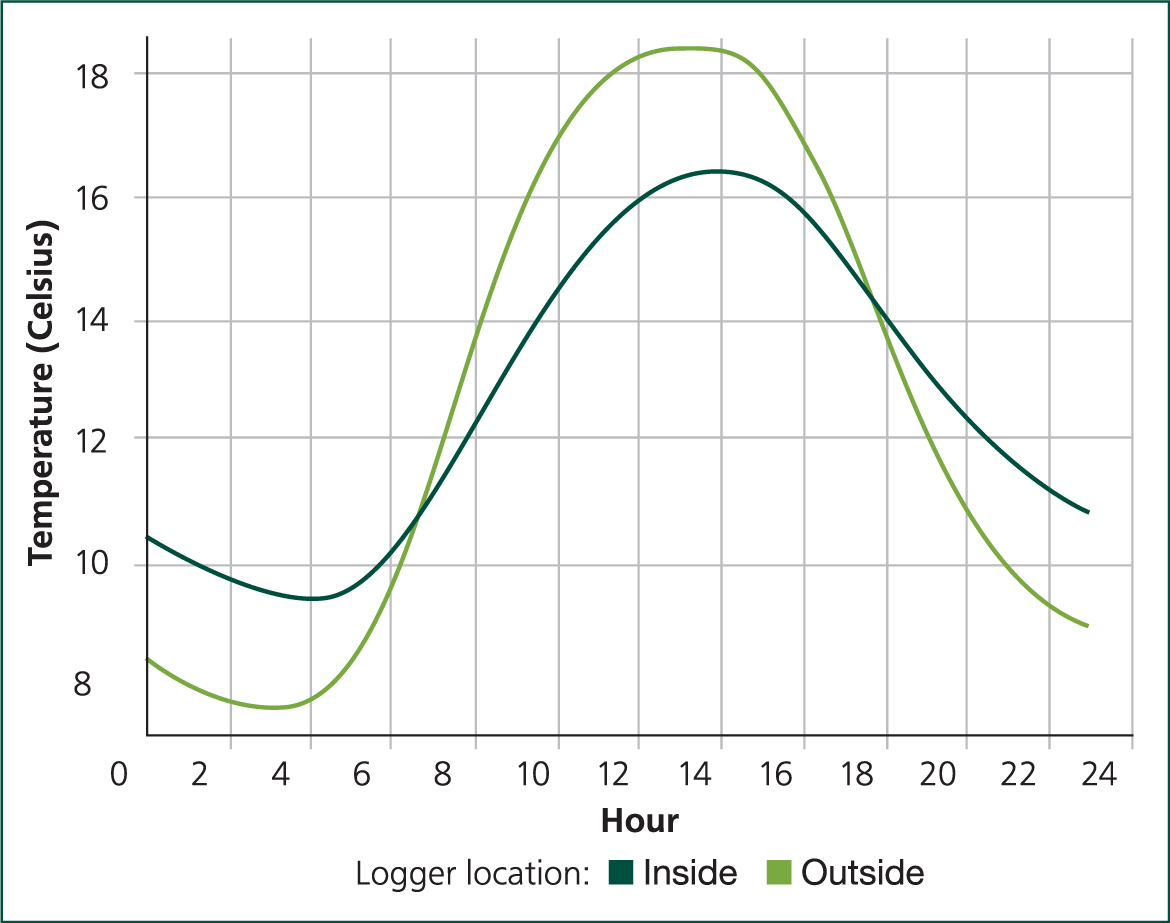
For natural ventilation to be utilised, the building needs to be located in an ideal position to maximise the prevailing wind, without any obstruction from other objects (e.g. other buildings), as well as having an inlet that can decrease the air speed, while not impeding the volume of fresh air entering the building. Therefore natural ventilation will rely on the direction of the wind and pushing it across the calf shed, which can be difficult if the shed is wide. A useful tool to look at is a wind rose, which is designed to summarise the wind conditions for a particular location, indicating the direction and speed of the wind as a percentage over a certain period of time. An example of a wind rose for Leicester is shown in Figure 2, and highlights that the 58.5% of the time the wind comes from the south, south-west or west. This is the most common direction for the wind in the UK, with the exception of spring when a north-east wind tends to be more normal. It is also worth considering that cross-ventilation of sheds is ineffective on days where there is minimal wind. For specifics on inlet design, refer to Robertson, 2020.
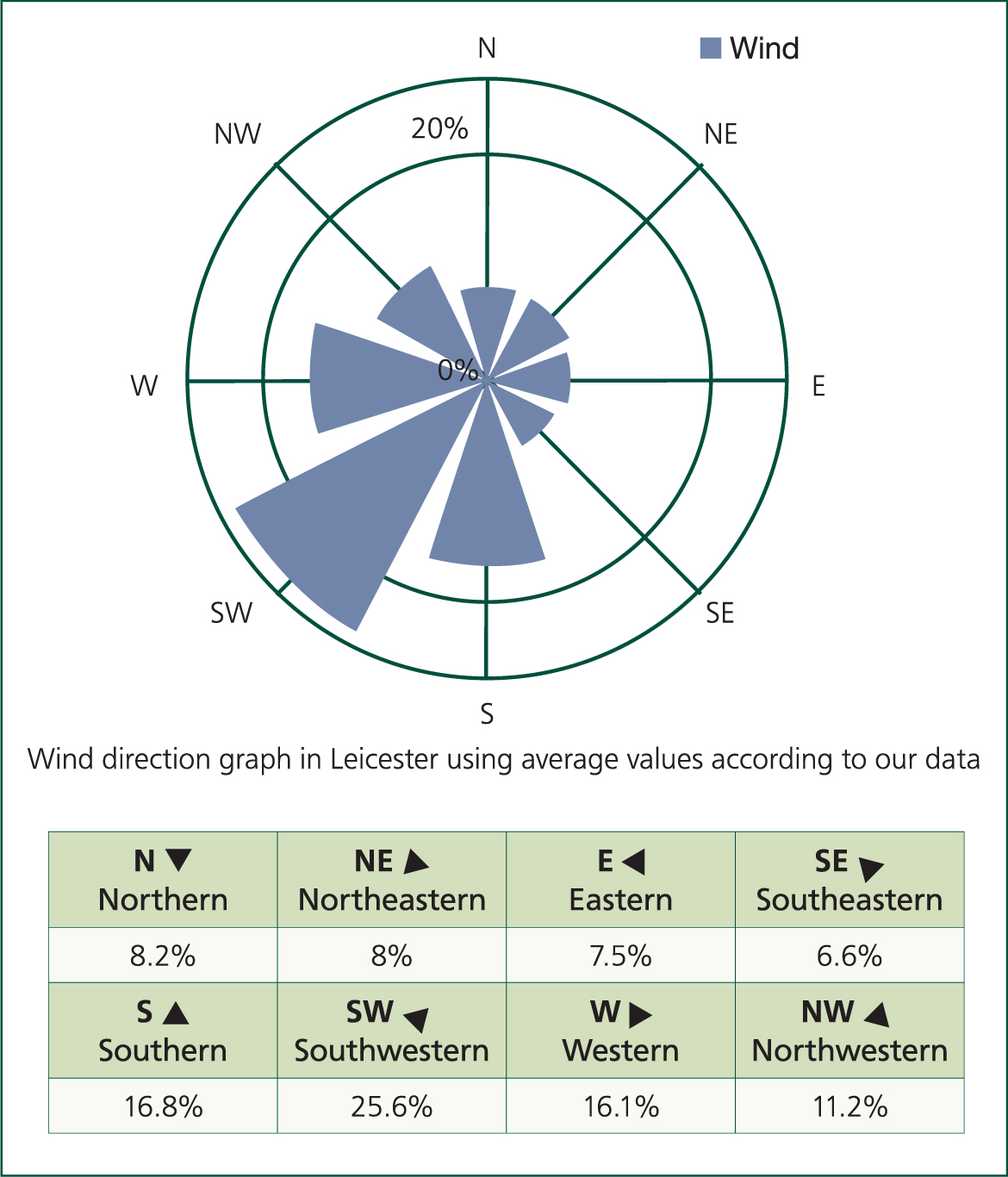
The outlet of the building is the escape route for old warm air and it is recommended to be 0.04 m2 per calf, utilising an open ridge design (Robertson, 2020). One worry of producers with using an open ridge is the potential for rain to enter the building; however for the vast majority of the year, the wind is blowing and creates a negative pressure over the open ridge, as a result of the wind hitting the open ridge causing it to speed up. This negative pressure results in the rain not entering the building. An alternative is the use of an elevated ridge cap with upstands on each side (Nordlund and Halbach, 2019).
Air quality assessments are difficult in clinical practice, as tools such as detectors for ammonia levels or manometers, have been found to be of little value in a BRD risk assessment (Lago et al, 2006). Culture of the airborne bacterial microbiome have been used in research to determine the bacterial load; however these methods have limitations in terms of determining the importance of high total viable count (TVC), when the majority of pathogens are non-pathogenic, as well as selective nature of certain culture media and the lack of viral and fungal detection. Higher TVC of bacteria have been reported to correlate with an increase in the susceptibility of BRD as a result of interactions with the host defences (Wathes et al, 1984). Increases in TVC on sheep blood agar in 13 barns in Wisconsin were correlated with increased environmental temperatures, use of solid pen dividers and ends on pens, higher nesting scores and the amount of straw present and decreased pen sizes; humidity and ammonia levels were not significantly correlated with TVC (Lago et al, 2006). However, care should be taken with associating high TVC and increased BRD risk, as factors such as the presence of solid dividers between calves and decreased nesting scores were also associated with a lower BRD prevalence (Lago et al, 2006). This may reflect the role that deep straw and solid dividers play in combating cold stress and conservation of energy. Currently there is inadequate research in this area to understand the role of the environmental microbiome in BRD, and how the microbiome is impacted by the housing conditions.
The ventilation requirements of a shed do not have a linear relationship with the stocking density, as a two-fold increase in stocking density requires a nearly tenfold increase in ventilation capacity required to maintain bacterial loads at similar levels (Gorden and Plummer, 2010). This results in inadequacies in ventilation of certain housing setups, and alongside suboptimal building design, has led to an interest in artificial mechanical ventilation. A summary of factors to consider when reviewing the ventilation of a calf shed is highlighted in Figure 3.
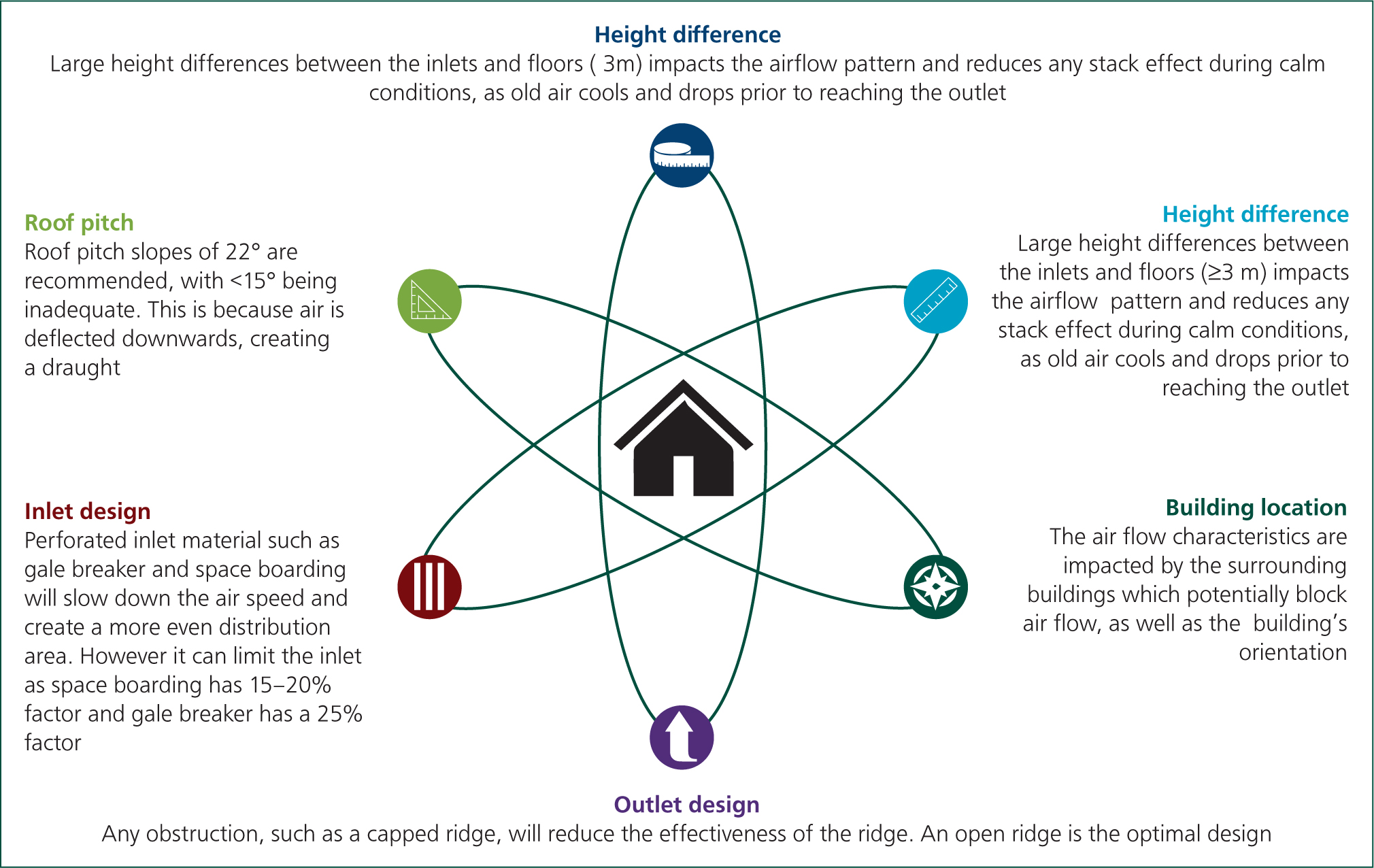
Use of positive pressure ventilation systems
Positive pressure ventilation (PPV) systems are usually designed to provide a minimum of four changes of interior air per hour. In order to do this calculations are based on an assumed normal stocking density and calculations are performed at the minimal winter ventilation rate (Bates and Anderson, 1979; Nordlund and Halbach, 2019). The tube should deliver fresh air without a draft into the calf's microenvironment, with equal distribution across the barn. The PPV tubes tend to be placed on the west facing side of a building to reduce the amount of time fighting the wind, in terms of drawing air in. The estimated costs are £1500 for installation and then daily electric costs of £2.10 per day (assuming electricity usage of 12.5 kWh and electricity costs of 17.5 p/kW) (Nordlund and Halbach, 2019). The cost of the tube may vary dependent on the material it is made from, with woven polyethylene tubes reported to provide the best overall value (Nordlund and Halbach, 2019). Some of the key features of a PPV tube are described in Figure 4.
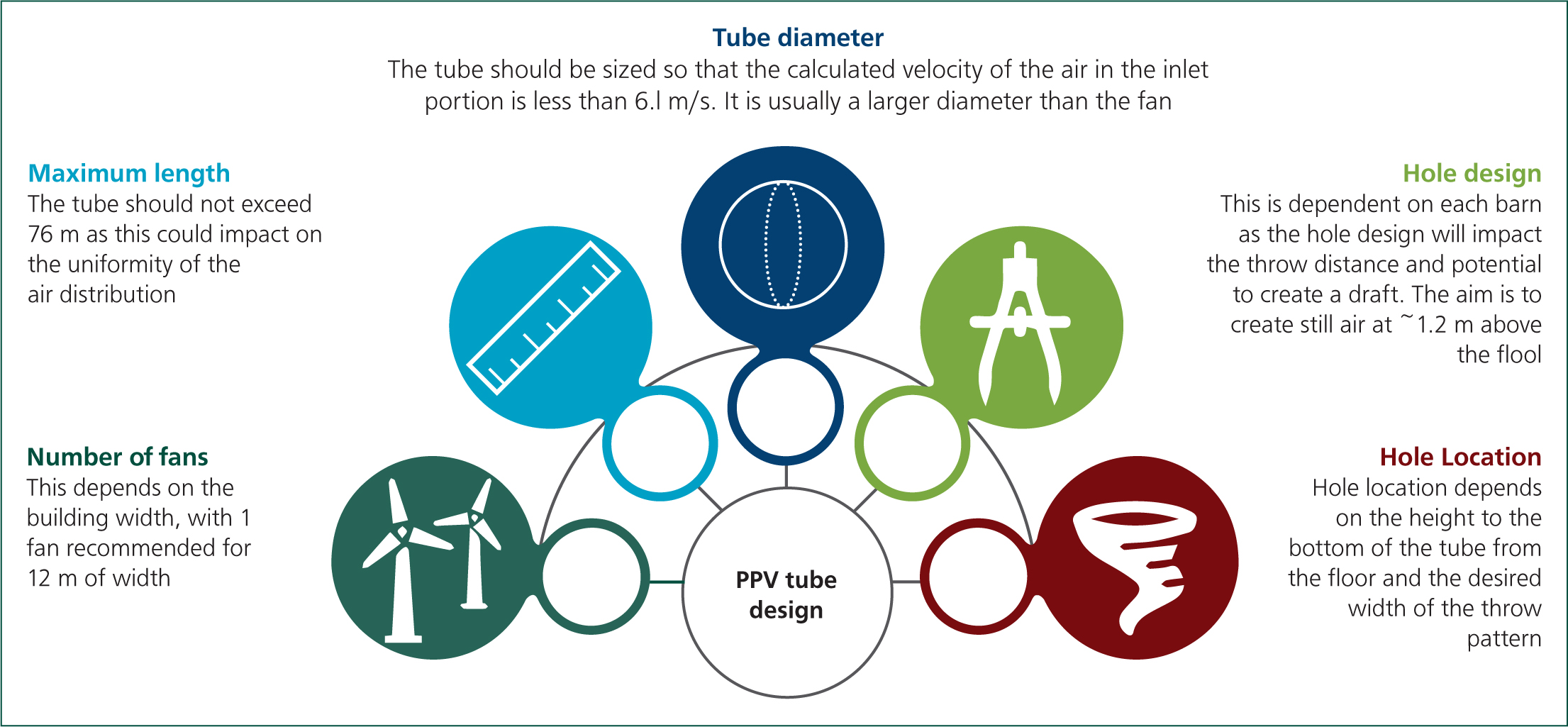
Use of negative pressure ventilation systems
Negative pressure ventilation (NPV) systems are used to aid natural ventilation and normally utilise fans that suck air through a barn. The extraction fans should be fitted to the highest point of the house roof apex and have an extraction capacity of 34 m3 per hour per calf (Nordlund and Halbach, 2019). NPV systems can be difficult to use in calf sheds because of the relatively small air exchange rates used in cold weather; as it is difficult to design inlet systems to distribute small volumes of fresh air throughout a barn tiny inlet openings are required and these are difficult to create in calf sheds. This is because the incoming air speed needs to be 4.2 m/s. In order for the fan to be able to extract the air, the inlet design is important to ensure a good mixing of air without drafts; the ideal design is long and narrow inlets, which are situated at eave height but at <2 m above the floor (Nordlund, 2008). Inaccurate NPV systems often results in poor fresh air distribution.
Drainage is an important aspect to investigate in calf housing as excess moisture in the environment will lead to an increase in the environmental humidity. The environmental humidity, in combination with temperature has been related to morbidity in pre-weaned calves; however this is thought to be correlated more to temperature than humidity (Urie et al, 2018). A study investigating the impact various factors have on pre-weaning DLWG indicated that there was an impact of mean daily outside humidity in the first month of life (Hyde et al, 2021). An elevated humidity can be a result of excess fluid/moisture coming from milk feeding equipment (automated and manual), as well as water troughs and poor ventilation. For more information on drainage design, please refer to Robertson, 2020.
The environment and daily liveweight gains
One of the largest issues with calf housing in the UK is dealing with cold environmental temperatures, which neonatal calves are susceptible to. It is easy for calves to lose heat because of a lack of insulating fat, which is <4% at 6 weeks of age, and having a high surface to mass ratio (Roland et al, 2016). Other reasons for cold susceptibility include the need to develop the ability to thermoregulate, which takes 2 months to develop (Roland et al, 2016), and the inability to generate heat through rumen fermentation (Collier et al, 1982). The lower critical temperature (LCT) of calves has been reported to be 20°C for <3 week old calves and 10°C for ≥3 weeks old. The mean daily temperature in England is below 10°C for 50% and below 20°C for 100% of the year, which suggests that cold stress is a permanent issue on UK farms. The impact of cold stress has been highlighted in terms of impacting on calf mortality and morbidity (Nonnecke et al, 2009; Urie et al, 2018Hyde et al, 2020), as well as impacting DLWG (Virtala et al, 1996; Donovan et al, 1998; Roland et al, 2016). DLWG will decrease as energy is directed towards keeping warm, despite the increased dry matter intake (DMI), as the increased DMI cannot match the increased heat production, assuming the calf is old enough to compensate by increasing DMI. Restrictive feeding of young calves has a negative effect on cold tolerance, and while outside of the scope of this article, should be considered when combating cold stress in preweaned calves.
Issues with calf housing that exacerbate the cold environmental temperature include the use of heat absorbing materials for calf housing construction. Concrete walls and floors do not provide ideal lying surfaces, because of the thermal conductivity of concrete resulting in heat being removed from the calf. One method of reducing the heat lost from the concrete floor is the placement of deep straw beds, which allows the calf to build up a layer of heat within the bedding. This has led to the development of the nesting scoring system to evaluate the sufficiency of bedding present in the calf shed (Lago et al, 2006). Other methods of reducing the impact of concrete and metal in a calf shed include use of plastic panelling for calves to lean against as the plastic has a reduced thermal conductivity in comparison to metal and concrete.
The prevention of drafts reduces the heat loss via convection, which is typically with windbreaks. Windbreaks offer protection for a distance that is 5 to 10 times their height (Mader, 2003). Windbreaks can be as simple as large straw bales placed in the direction of the wind. The amount of time calves spend behind a wind break is correlated with the wind speed (Olson and Wallander, 2002), and can be easy to utilise at different times of the year, e.g. mid spring when the wind direction tends to be from the east, compared with the majority of the time when it is from the south to west direction. The use of shelters in group housing environments can be an effective method of reducing cold stress, as if designed correctly calves are able to heat the small sheltered area and generate a stack effect (thus an outlet must be included in the design, otherwise air is recirculated and humidity increases). Research has highlighted that the inside temperature of hutches used as sheltered areas is usually higher than the ambient temperature, with one study reporting an average increase of 2.5°C (Hoshiba, 1986), and therefore can be an effective method of increasing the environmental temperature if done correctly.
Other methods of increasing the environmental temperature include the use of calf jackets; however calf jackets have been reported to have no significant impact on DLWG (Earley et al, 2004; Scoley et al, 2019; Hyde et al, 2022). Calf jackets have been reported to have the same impact as 1 unit of nesting score to aid prevention against the cold (Nordlund and Halbach, 2019), and therefore their role in combatting cold stress is currently unclear. Heat lamps, while commonly used for neonatal lambs, are less commonly utilised in calf housing. Research has indicated that use of heat lamps has a positive impact on DLWG (Bhat et al, 2015; Hyde et al, 2022). The heat lamps that were used in a randomised control trial on a 550 dairy herd in the UK were 1 kW patio heaters and resulted in ~5°C increase in pen temperature (Figure 5) (Hyde et al, 2022). These differ from the traditional heat lamps used for lambs, which are 250 W, but are likely to only increase the pen temperature by ~1°C. The calves showed preferences for the areas within the pen where the heat lamp was in use, suggesting a positive welfare impact. However these heat lamps cost £4.13 per day to run (based on 1 kw usage per hour and 17.2 p/kW electricity cost), which may be a barrier to more generalised use in calf housing, especially when compared with the cost of £0.50 per day per calf for increasing milk feeding from 6 litres to 8 litres at 125 g/litre (extra 4.89 MJ), using a 24% protein, 20% fat commercial milk replacer (at £2000 per tonne). Another method of artificially increasing the environmental temperature includes hearing the air entering the building and distributing it along PPV tubes. This is often achieved using propane or natural gas heaters (Nordlund and Halbach, 2019); however these systems are not common in the UK.
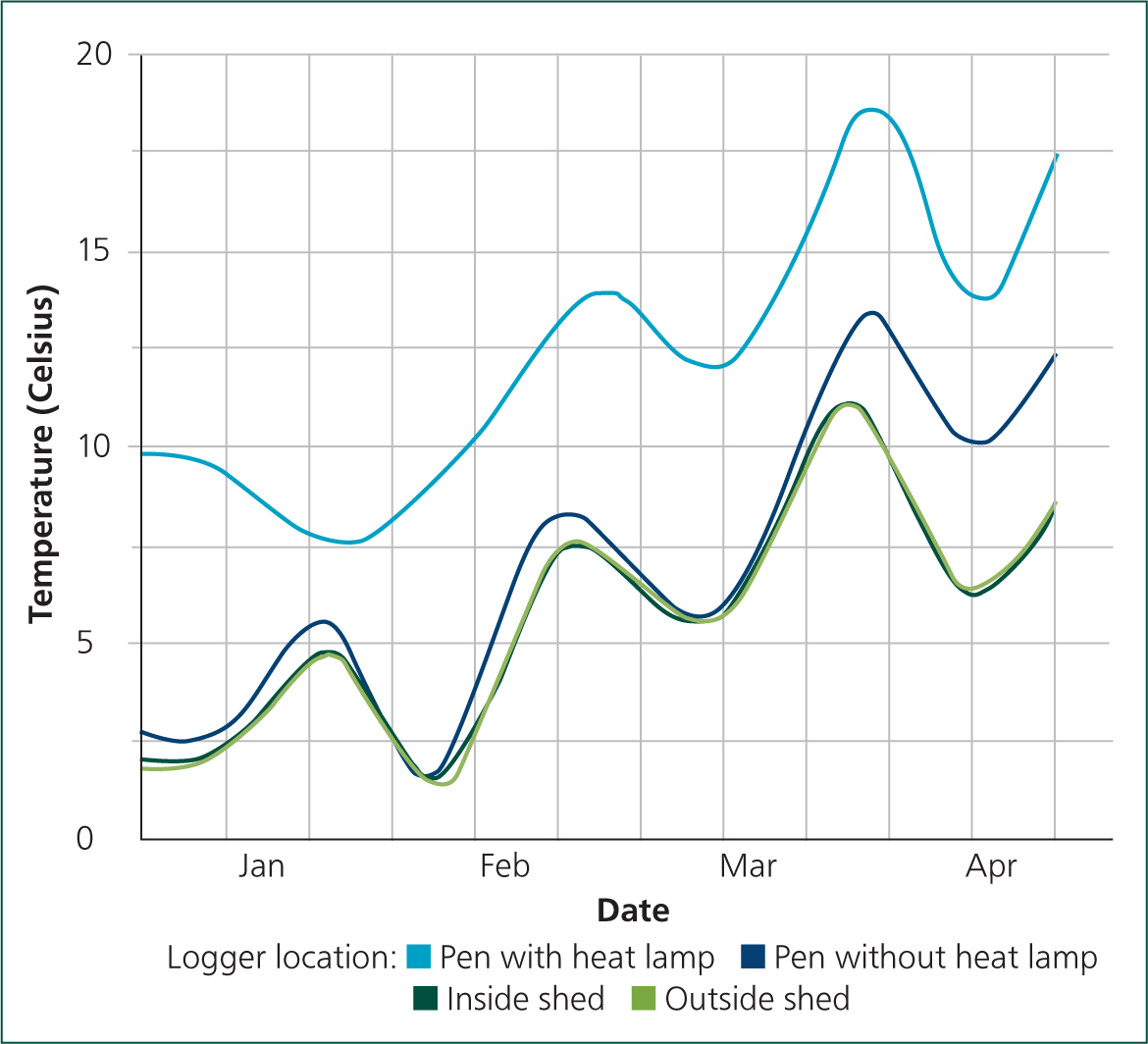
Impact of socialisation on production and disease
The practice of individually housing calves has been reported as a welfare issue, because of social deprivation (Costa et al, 2019). There has been a large interest into the benefits of group housing calves, resulting in compulsory group housing of calves for some supermarket aligned farmers. This has been driven by a desire for improved welfare, with calves appearing to be highly motivated to initiate social contact with other calves (Chua et al, 2002) and showing a preference for a known peer in contrast to an unfamiliar calf, with these early life social connections having been shown to be long lasting (Costa et al, 2016a). There are reported behavioural benefits to socialisation, including reduced fear of new situations, which lasts into later life. Social housing of calves has also been shown to increase gains in bodyweight, most likely because of increased dry matter intake, which is as a result of decreased neophobia and increased solid feed intakes at an earlier age, which may reflect social group learning. Social learning allows individuals to learn from the positive or negative effects on another individual; this type of learning is thought to be important in the development of feeding behaviour (Costa et al, 2016b). These benefits are being seen by farmers in the UK, where farmers using group housing systems were significantly more likely to comment on the benefits of social interactions and the larger space allowance offered by group housing, compared with farmers who individually housed calves (Mahendran et al, 2022). The increase in space allowance has been reported to impact on the play behaviour of calves, with calves kept in larger pen sizes demonstrating more play behaviour (1.5 m2 vs 3 m2) (Jensen and Kyhn, 2000).
One of the challenges of group housing is the risk of horizontal disease transmission and potential for a decrease in the ability to individually monitor calves, which is one of the main worries for farmers switching from individual to group housing (Mahendran et al, 2022). However, there is little evidence of a consistent relationship between individual calf housing and improved calf health, as disease transmission is a complex process with multiple risk factors attributing to the risk of disease.
Part of the issue with group housing can be the method of grouping; for instance disease incidences are lower in groups if the farm operates as an all in all out (AIAO) system, rather than continuously introducing and removing calves. The aim of AIAO is to prevent disease transmission and allow for effective cleaning and disinfection between batches. The impact of groupings in group housing is highlighted in Table 1, which highlights that large groups of calves (>10) have an increased odds of BRD; however the age range, space allowance, housing ventilation and drainage etc. all play roles in this, and will vary between farms.
Conclusion
Housing plays a major role in the welfare and productivity of preweaned calves, with multiple factors playing roles in terms of disease rates, ability to exhibit normal social interaction and performance in terms of DLWG. Small changes to the housing design and environment of calves can result in improved performance and better welfare for calves, alongside education of producers in terms of how to optimise calf housing.
KEY POINTS
- Changes can be made to older buildings to improve calf health and performance.
- It is extremely difficult to naturally ventilate a calf shed 365 days a year in the UK, because of weather conditions and the inability of calves to generate a stack effect.
- A calf shed is generally a cold place, which means calves are almost constantly using energy to keep warm.
- Group housing has both positive welfare and production benefits, especially if all in all out (AIAO) systems are utilised.


